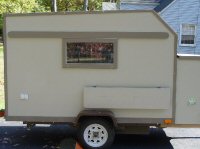Newbie Looking Leaning Towards a Foamie (My Question Thread)
Moderator: eaglesdare
Re: Newbie Looking Leaning Towards a Foamie
Are you thinking about which of the holes you will use? I'm thinking that the two widest ones and one of the lower ones would be more than adequate. My thinking is that the extra holes are provided for nailing, whereas you are screwing, which is much stronger.
KC
My Build: The Poet Creek Express Hybrid Foamie
Poet Creek Or Bust
Engineering the TLAR way - "That Looks About Right"
TnTTT ORIGINAL 200A LANTERN CLUB = "The 200A Gang"
Green Lantern Corpsmen
My Build: The Poet Creek Express Hybrid Foamie
Poet Creek Or Bust
Engineering the TLAR way - "That Looks About Right"
TnTTT ORIGINAL 200A LANTERN CLUB = "The 200A Gang"
Green Lantern Corpsmen
-

KCStudly - Donating Member
- Posts: 9640
- Images: 8169
- Joined: Mon Feb 06, 2012 10:18 pm
- Location: Southeastern CT, USA
Re: Newbie Looking Leaning Towards a Foamie
KCStudly wrote:Are you thinking about which of the holes you will use? I'm thinking that the two widest ones and one of the lower ones would be more than adequate. My thinking is that the extra holes are provided for nailing, whereas you are screwing, which is much stronger.
I did not think about that. I figured I'd just screw them all up. You make a good point though, they are probably not all required.
Do you have any thoughts on the post I made just about yours (bottom of page 5), where they guy on the other forum pointed out that wood and steel have different thermal expansion rates? Is that likely to be an issue with how I'm planning to build it?
Overthinking again.

-

jseyfert3 - Teardrop Master
- Posts: 285
- Images: 1
- Joined: Sun Jan 05, 2014 9:13 am
- Location: Peoria, IL, USA





 Now that is really a lot and that is at full production and if it is not, they want 6 dollars a year. So you figure it out. It is not worth the paperwork for me but it is fun. So if discussing the .000074 and the perfection of all the ratios just make sure it is worth your time and effort to change it for the better. so......
Now that is really a lot and that is at full production and if it is not, they want 6 dollars a year. So you figure it out. It is not worth the paperwork for me but it is fun. So if discussing the .000074 and the perfection of all the ratios just make sure it is worth your time and effort to change it for the better. so......



 d units where the unit sits on the ground next to the camper or on the tongue may have portable or permanent hoses to duct the air to and from, but you will need to hack the thermostat and controls for remote operation, and build the necessary shrouds.
d units where the unit sits on the ground next to the camper or on the tongue may have portable or permanent hoses to duct the air to and from, but you will need to hack the thermostat and controls for remote operation, and build the necessary shrouds.